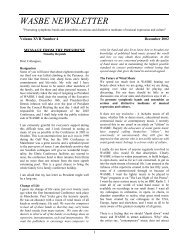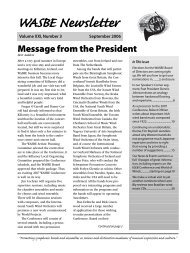March 2011 - World Association for Symphonic Bands and Ensembles
March 2011 - World Association for Symphonic Bands and Ensembles
March 2011 - World Association for Symphonic Bands and Ensembles
Create successful ePaper yourself
Turn your PDF publications into a flip-book with our unique Google optimized e-Paper software.
composition was entirely <strong>and</strong> exclusively<br />
based on popular song themes. Mind that<br />
the majority of the selected songs are of<br />
African origin rather than of Portuguese<br />
origin. Absil had found a volume of Brazilian<br />
folk songs in the library of the Royal Brussels<br />
Conservatory of Music. He went to the<br />
embassy of Brazil in Brussels in order to<br />
make further investigations <strong>and</strong> discovered a<br />
lot of material he could use, such as popular<br />
Brazilian tunes, children’s songs <strong>and</strong> religious<br />
hymns. The five songs processed in this<br />
rhapsody are successively an African lament<br />
“Xango”, two children’s songs “Coco dende<br />
trapia” (the coconut is about to fall) <strong>and</strong><br />
“Fotorototo”, a warrior chant “Cabocha<br />
bonita”, a religious hymn “Saō Pedro”,<br />
referring to the arrival of Portuguese<br />
Christian missionaries, <strong>and</strong> finally another<br />
African lament “Anilka” which reminds the<br />
presence of black laborers on the Brazilian<br />
soil. The transcription was premiered by the<br />
Royal <strong>Symphonic</strong> B<strong>and</strong> of the Belgian<br />
Guides, conducted by Yvon Ducène, at a<br />
homage concert paying a tribute to the 80<br />
year old composer on April 12, 1973.<br />
Besides the Rhapsodie Brésilienne, also<br />
Rites <strong>and</strong> Danses Bulgares were on the<br />
program. Absil had attended the final<br />
rehearsal <strong>and</strong> Yvon Ducène had presented<br />
the composer with the b<strong>and</strong>’s honorary<br />
medal.<br />
FANTAISIE CAPRICE (Opus 152)<br />
In 1970/1971, Absil wrote Fantaisie –<br />
Caprice opus 152 <strong>for</strong> alto saxophone 25 <strong>and</strong><br />
orchestra <strong>and</strong> dedicated it to François<br />
Daneels 26 . In 1973 he made a version <strong>for</strong><br />
<strong>Symphonic</strong> B<strong>and</strong> <strong>for</strong> the Guides B<strong>and</strong>. The<br />
title refers to the boundless imagination<br />
Saxophonist Elie Apper, soloist at the<br />
première per<strong>for</strong>mance of “Fantasie Caprice”<br />
on January 25, 1974<br />
which guided the composer while writing<br />
this one part composition. It starts with the<br />
presentation of the chromatic theme; then<br />
an “Andante Mysterioso” leads to an<br />
“Allegretto”, both characterized by several<br />
rhythmical changes. The <strong>and</strong>ante comes<br />
back <strong>and</strong> is now followed by a ‘Vivo’ giving<br />
plenty of opportunities to display the thrilling<br />
technical qualities of both the instrument<br />
<strong>and</strong> the soloist. The latter can plainly<br />
demonstrate his virtuosity in the traditional<br />
cadenza <strong>and</strong> the “Finale, Vivo”. This<br />
transcription is commonly regarded as Absil’s<br />
very last composition. It goes without saying<br />
that it was premiered by the Royal<br />
<strong>Symphonic</strong> B<strong>and</strong> of the Belgian Guides,<br />
Yvon Ducène conducting, in the radio<br />
concert hall of the Belgian Broadcasting<br />
Company on January 25, 1974.The soloist<br />
was Elie Apper 27 . (Published by Lemoine,<br />
Paris)<br />
Transcriptions by others<br />
In order to complete this survey, we also<br />
mention some transcriptions made by<br />
military b<strong>and</strong> conductors with Absil’s<br />
approval.<br />
LITTLE SUITE (Opus 20)<br />
In 1935 Jean Absil composed his Petite<br />
Suite opus 20 (Little Suite) <strong>for</strong> small<br />
orchestra. That very same year it was<br />
transcribed <strong>for</strong> Wind B<strong>and</strong> by Martial Dury 28 ,<br />
a musician of the Guides B<strong>and</strong>. In this threepart<br />
“Little Suite” the composer evokes the<br />
children’s world. In three little portraits, he<br />
depicts scenes from the daily life of the<br />
children: 1) “marche” is an evocation of a<br />
merry children’s song; 2) “conte” suggests<br />
a fairy tale in a mysterious wood, <strong>and</strong><br />
3) “carrousel” describes a merry-go-round<br />
at a fun fair. (Published by Bosworth,<br />
London).<br />
Martial Dury also orchestrated Prélude<br />
tragique et Funèbre à la Mémoire du<br />
Bourgmestre Schmidt <strong>for</strong> <strong>Symphonic</strong> B<strong>and</strong>.<br />
Absil had composed this dirge as a tribute to<br />
Louis Schmidt, mayor of the Brussels municipality<br />
Etterbeek since 1933, condemned by<br />
the Germans as a member of a resistance<br />
movement. He died in captivity in Breslau in<br />
1944.<br />
TWO SUITES FROM “DONKEYSKIN”<br />
(Peau d’Âne)<br />
In 1938 Absil composed “Peau d’Âne”,<br />
Féerie lyrique (Donkey Skin, a lyrical fairy<br />
scene) as stage music <strong>for</strong> Henri Géhon’s 29<br />
play “Féeries” based on Charles Perrault’s<br />
fairy tale “Peau d’Âne” (Donkeyskin). By the<br />
time Absil had written the music, intended<br />
<strong>for</strong> a small theatre at the (now famous) Rue<br />
des Bouchers in Brussels, the theatre had<br />
already closed down. Yet the music was<br />
premiered on the air by the I.N.R. Radio<br />
Orchestra, conducted by Jean Kumps, on<br />
October 31, 1938. Though the play was<br />
never per<strong>for</strong>med in Belgium, it was indeed in<br />
Rome <strong>and</strong> even in New York under the<br />
auspices of the ‘International Society <strong>for</strong><br />
Contemporary Music’. 14 years later, in<br />
1952, Absil turned part of this music into an<br />
orchestral suite consisting of four parts:<br />
“Cortège”, “Valse”, “Pavane’ <strong>and</strong> “Allegro<br />
giocoso”. Simon Poulain 30 made a<br />
transcription <strong>for</strong> <strong>Symphonic</strong> B<strong>and</strong> entitled<br />
Suite d’orchestre extraite de Peau d’Âne,<br />
later known as ”First Suite from Peau<br />
d’Âne”. Sometime later, Absil wrote another<br />
suite with themes from the same stage music<br />
<strong>and</strong> called it “Trois Airs de Ballet”. Once<br />
more, Simon Poulain made a transcription<br />
<strong>for</strong> <strong>Symphonic</strong> B<strong>and</strong> entitled Trois airs de<br />
ballet extraits de Peau d’Âne consequently<br />
named “Second Suite from Peau d’Âne”.<br />
HOMAGE TO SCHUMANN<br />
In 1946, Absil wrote Hommage à Schumann<br />
(opus 67) <strong>for</strong> piano, consisting of<br />
three parts: <strong>March</strong>e – Impromptu –<br />
Mouvement perpétuel. Franz Wangermée 31 ,<br />
the then conductor of the Guides B<strong>and</strong>,<br />
orchestrated the piece <strong>for</strong> <strong>Symphonic</strong> B<strong>and</strong><br />
<strong>and</strong> conducted the premiere per<strong>for</strong>mance by<br />
the <strong>Symphonic</strong> B<strong>and</strong> of the Belgian Guides<br />
at a b<strong>and</strong>st<strong>and</strong> concert in the Royal Park<br />
Brussels during the summer of 1946.<br />
Finally we should mention a transcription<br />
of the Scherzo from the 1 s t Symphony by<br />
the military b<strong>and</strong>master Alphonse Courtain<br />
(1880–1960) – published by Scherz<strong>and</strong>o.<br />
Excepted when stated otherwise, all<br />
mentioned compositions are “in care of<br />
CeBeDeM” Brussels 32 .<br />
Discography:<br />
Rites: Royal <strong>Symphonic</strong> B<strong>and</strong> of the<br />
Belgian Guides (Norbert Nozy), CD RGIP<br />
87056,<br />
Roumaniana: Royal <strong>Symphonic</strong> B<strong>and</strong> of<br />
the Belgian Guides (Norbert Nozy), CD RGIP<br />
87047,<br />
Roumaniana: Royal Military B<strong>and</strong>, The<br />
Netherl<strong>and</strong>s (Pierre Kuypers) CD KMK 002.<br />
Rhapsodie Brésilienne, Rhapsodie<br />
Flam<strong>and</strong>e, Fantaisie-Caprice, Rites &<br />
Danses Bulgares: Royal <strong>Symphonic</strong> B<strong>and</strong> of<br />
the Belgian Guides (Norbert Nozy) CD RGIP<br />
87096.<br />
Roumaniana & Rites: Royal <strong>Symphonic</strong><br />
B<strong>and</strong> of the Belgian Guides (Norbert Nozy)<br />
WWM (<strong>World</strong> Wind Music) 500.117<br />
WASBE <strong>World</strong> 25


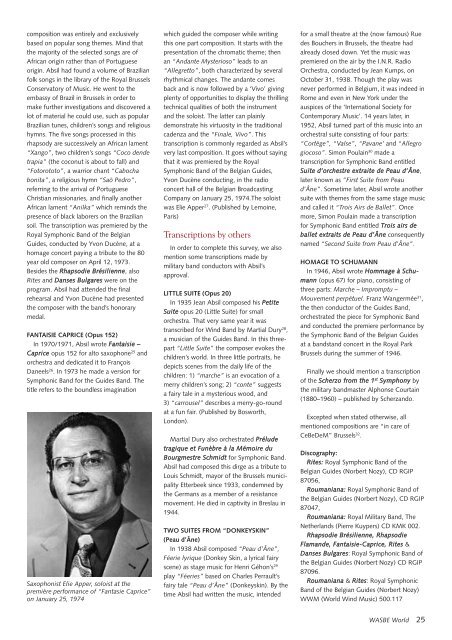
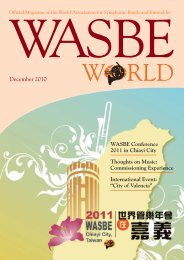
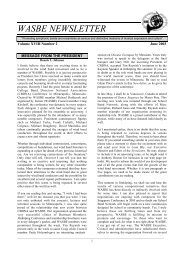

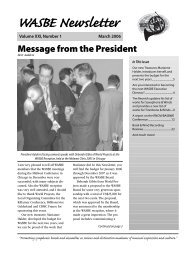
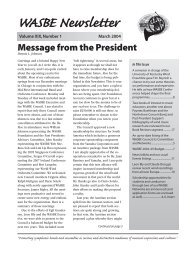

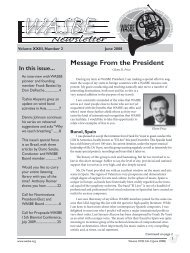
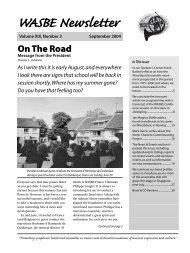
![application form [PDF; 110K]](https://img.yumpu.com/37266203/1/190x253/application-form-pdf-110k.jpg?quality=85)
